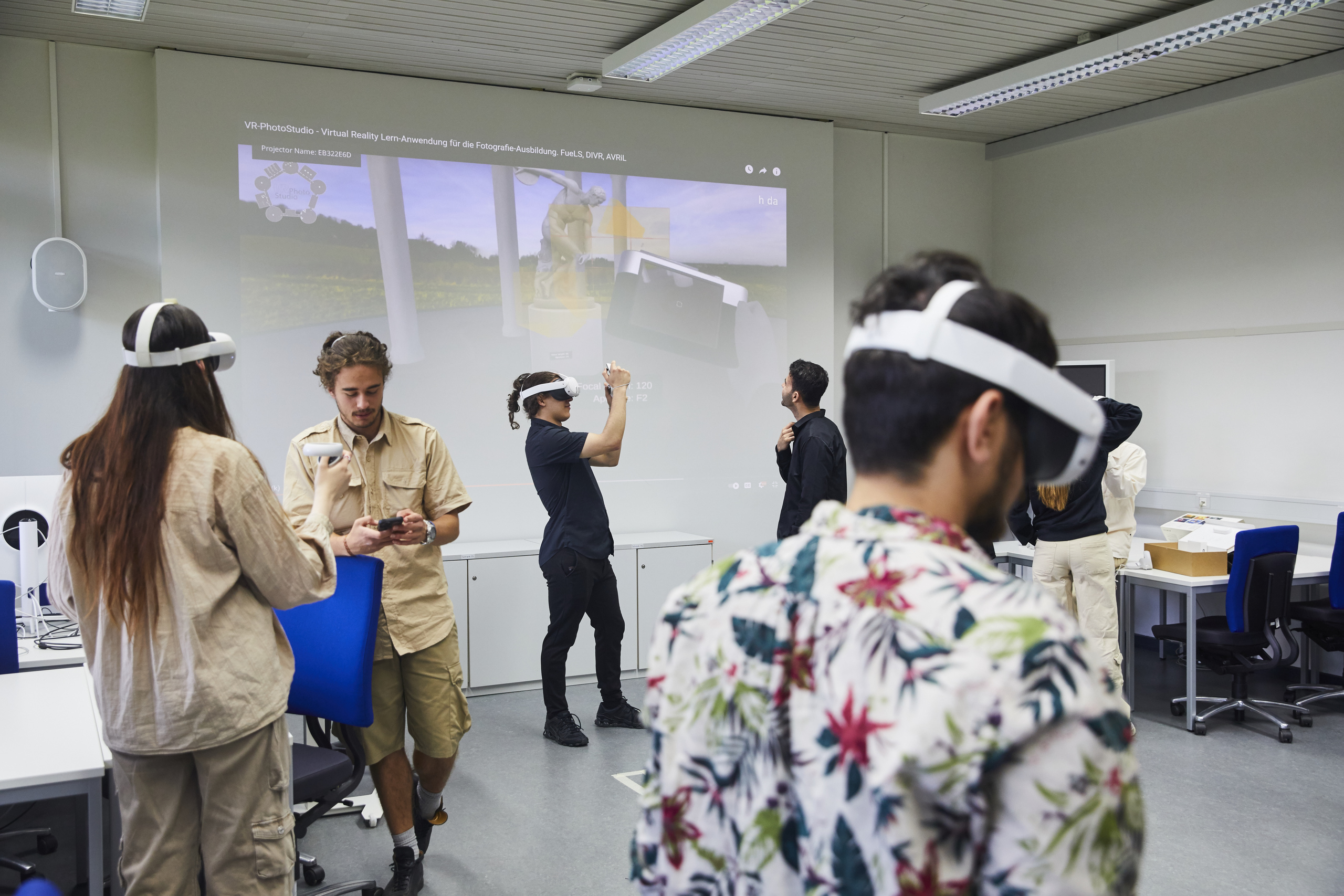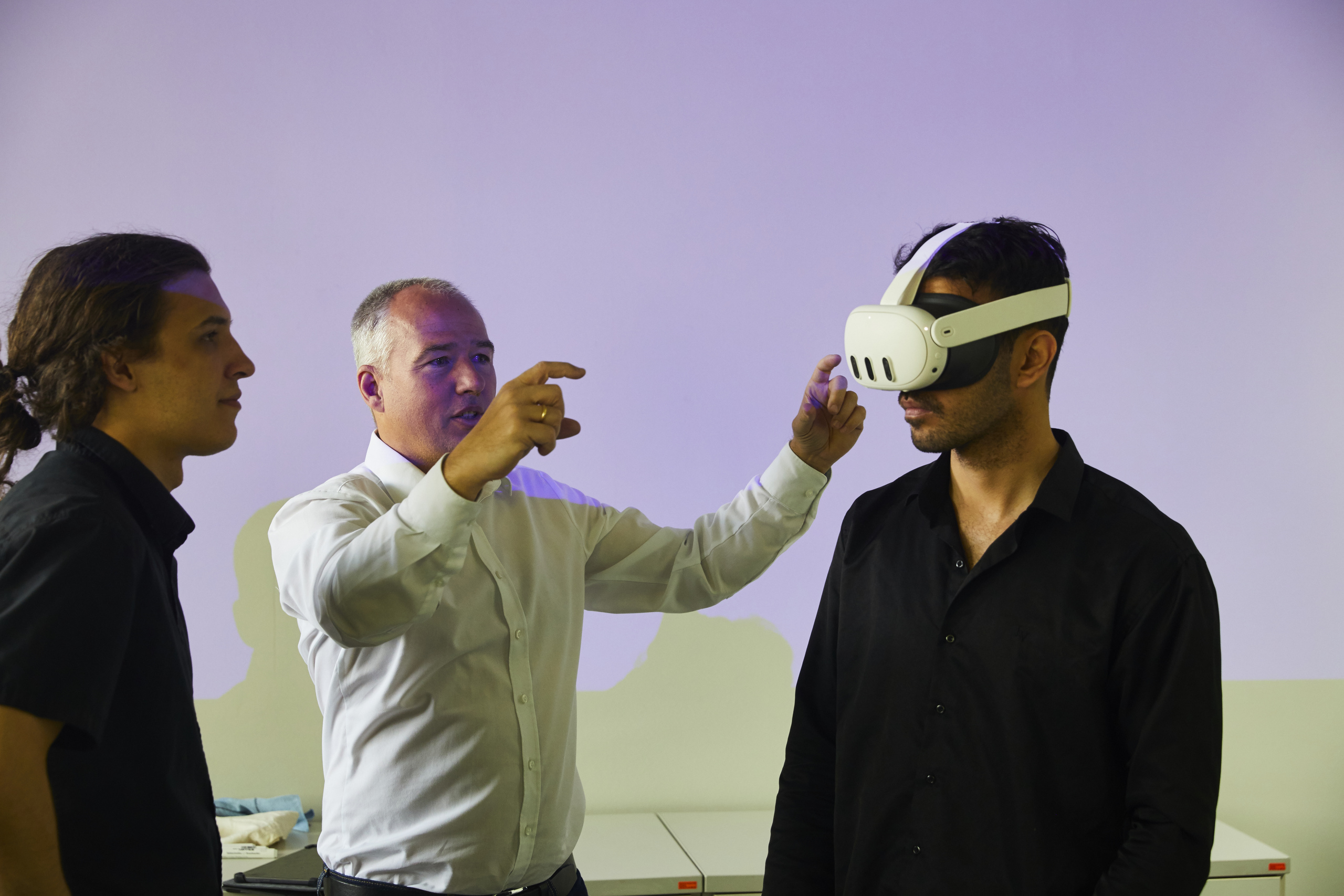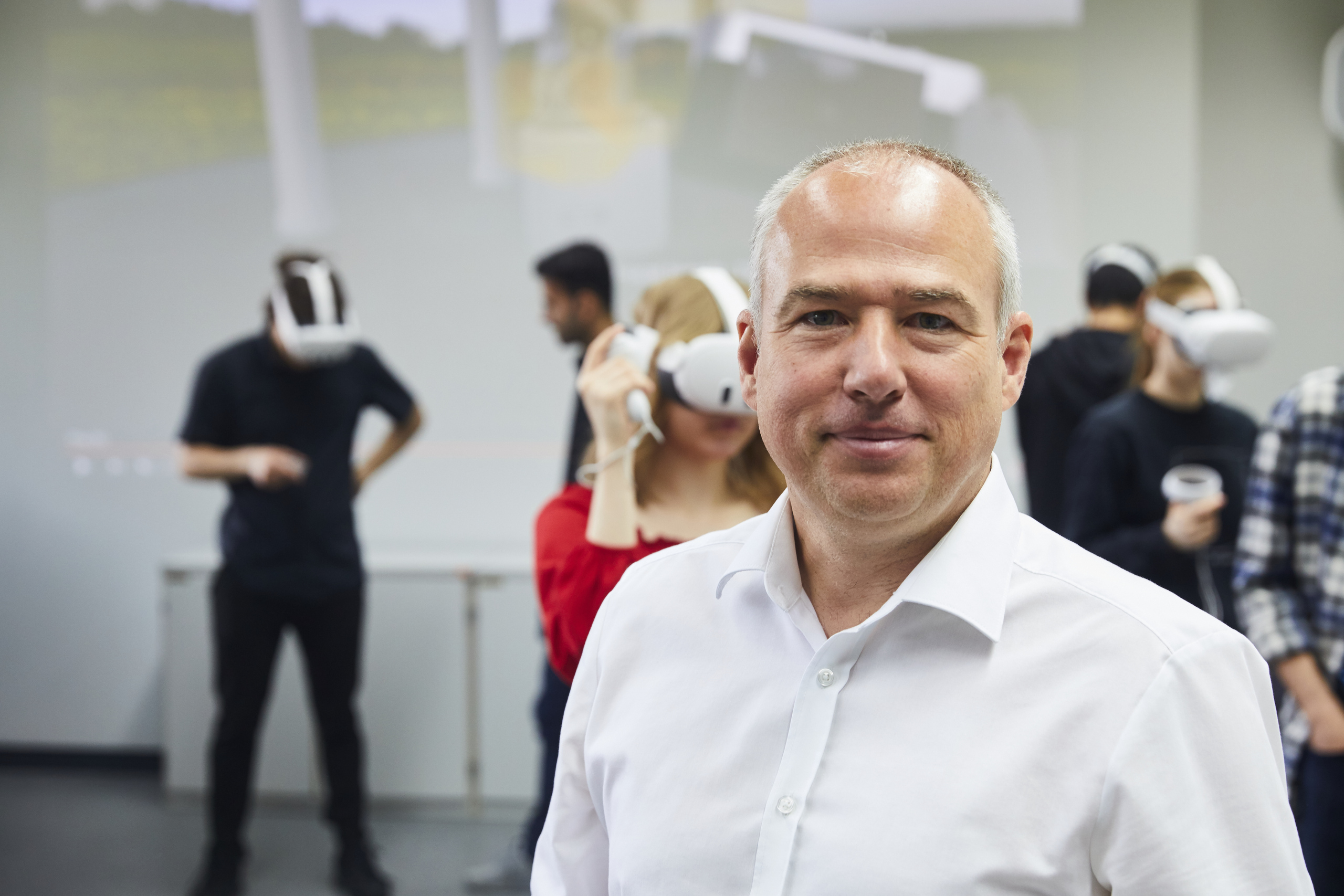Future Learning Spaces

During the coronavirus pandemic, digital tools gave remote teaching a substantial boost. Video conferencing software such as BigBlueButton, online consultation hours, e-lectures, chats and forums are now standard in everyday university life. How can other virtual learning scenarios be incorporated into teaching in a way that makes didactic sense? This is the question that the collaborative project “fuels – Future Learning Spaces” is exploring, for which the Hessian Ministry of Higher Education, Research, Science and the Arts has awarded funding of €2.1m. The Faculty of Computer Science, the Faculty of Media and the University Didactics & Digitalisation Department at h_da are playing a significant role.
By Astrid Ludwig, 10.6.2024
Put your headset on and immerse yourself in the virtual world. What appears before our eyes has almost nothing in common with conventional laboratories, studios or seminar rooms. It is more like a world of science fiction in which we can beam ourselves to other places: suddenly we are standing in a room where the lights are dimmed. A camera hovers in the air, which our somehow ethereal hands can grasp and operate with two controllers, a kind of joystick, to open doors with a beam of light – to a meadow full of flowers and trees against an azure sky, for example. It is a 360° panorama with a statue of a Greek discus thrower in the centre. We can walk around it and take pictures from all perspectives and angles. The results of our photo shoot immediately appear in picture frames on the walls for us to inspect. Are exposure time, perspective, and sharpness correct? Might the composition profit from a Greek column in the background, how do the spotlights influence the play of light and shadow or the overall atmosphere? In the past, students were obliged to reserve a slot – and a short one at that – in the often booked-out real-life photo studio, but now they can test, adjust and optimise everything using Virtual Reality headsets, every which way and independently of time.
New technologies should be fun, but expedient too
Welcome to the photo studio of the future – on the Media Campus of Darmstadt University of Applied Sciences in Dieburg. The VR-PhotoStudio was developed and designed by Andreas Fuchs, at that time a Master’s student in Digital Media and Applied Computer Science, now a doctoral candidate and research associate at h_da within Hesse’s collaborative project “fuels – Future Learning Spaces”. Darmstadt University of Applied Sciences, the Technical University of Darmstadt and Goethe University Frankfurt are working together to develop innovative applications for teaching. The Hessian Ministry of Higher Education, Research, Science and the Arts has awarded funding of €2.1m for the project, of which around €800,000 will go to h_da.
VR-PhotoStudio - Virtual Reality Lern-Anwendung für die Fotografie-Ausbildung. FueLS, DIVR, AVRiL
The aim is to use 360° video technology, augmented and virtual reality, and artificial intelligence to create the learning scenarios of the future. Does this mean that lectures will soon resemble a kind of video game or gamified challenge? “The new technologies should not only be fun but also offer value added and support teaching in a meaningful way,” says Andreas Fuchs. Scientists and researchers working in didactics, design, development and programming at the participating universities are joining forces to create a mixture of physical and digital elements – known as hybrid spaces. The aim in the future is to supplement a laboratory or a field trip destination with digital information and learning content, for example, and to support university processes with the help of augmented reality approaches. Or – as in the case of the VR-PhotoStudio developed by Fuchs – shift them into the virtual realm as a place to practise.
Testing already underway in many disciplines
The project started two years ago, reports Professor Paul Grimm, who teaches Virtual and Augmented Reality at the Faculty of Media. Since then, there has been a lot of input and new ideas. “We make use of the synergies between the various universities.” The teams have developed the “fuelsME” platform, for example, which they can use to test their own VR developments and make them available to the other partners, who in turn can access and use them for their own scenarios, facilities or study programmes. Are the new learning scenarios equally suitable for all faculties? “Using them needs to be considered and assessed on an individual basis,” says Professor Grimm. “The greatest advantages of using Virtual or Augmented Reality will always result where there is a connection to three-dimensional space.”
At Darmstadt University of Applied Sciences, testing is underway in cooperation with the University Didactics & Digitalisation Department. The “Augmented and Virtual Reality Design” study programme at the Faculty of Media is already using the new technologies. But a VR application is also planned for mathematics, reports Professor Grimm. “To help in linear algebra, to better demonstrate movements and rotations in 3D space, make them more tangible and easier to understand.” At Goethe University Frankfurt, for example, political topics are discussed that benefit from the debates taking place in a virtual plenary chamber of the European Parliament. However, applications in medicine or foreign language programmes are also conceivable. Grimm says that other VR environments exist that are designed to support language students by transporting them to a visual locality that suits the learning situation. To a cinema foyer, for example. “Appealing to several senses at the same time enhances learning,” explains Grimm.
The AI application is used at h_da not only in the VR-PhotoStudio but also in the Imaginarium. This is a virtual space that doctoral researcher Andreas Fuchs also designed. It is his specialist field: he has already won the XR Science Award for an immersive application for the second time and also received the Best Paper Award at the international conference of the IEEE (Institute of Electrical and Electronics Engineers), an engineering association based in the USA.
You need VR glasses when you visit the Imaginarium, too. They beam you into a round, brightly lit room that resembles a museum. With posters and paintings on the walls, tree-like greenery and a shaft of light in the middle. Up to 20 students can log into the virtual space at any one time. “The Imaginarium is all about creativity and brainstorming, about developing ideas together,” explains Fuchs. All participants appear as avatars slightly reminiscent of the stormtroopers in the Hollywood classic “Star Wars”.
fuels: Imaginarium - Immersive Spaces for Creativity: Smart Working Environments
In the two rooms of the Imaginarium, the students can move around freely and chat to each other. An voice-AI listens to them and produces images to match their conversations. If someone is mulling over new luggage concepts for trains, for example, they will see innovative designs for compartments that can be reconfigured according to their own preferences. The Imaginarium reacts to its users’ individual moods and adjusts the lighting, colours or even the sound accordingly to encourage a sense of well-being and support work processes. In this way, users can work together on the same topic while their own virtual space changes adaptively. “The added value of this application is that it stimulates fresh ideas and ways of thinking, allowing you to develop new concepts beyond your own imagination,” says Fuchs.
A very practical experience
On this day, Professor Grimm introduces the students in the second semester of “Augmented and Virtual Reality Design” to the world of the VR-PhotoStudio. The aim is for them to use the new application as an autarchic practice room. The students have brought their own VR headsets with them or else use the university’s equipment. Professor Grimm lets them enter the new learning space in pairs, with only one person at a time allowed to explore the virtual space while the other ensures that the pairs do not collide or walk into tables or walls in the real-life seminar room.
Mirabella, a student from Italy, is full of exuberance and already well-versed in using a VR headset. She kneels down, changes position and operates the controllers just like a real camera. “It’s great fun,” she says afterwards. She likes the fact that she can practise taking photos under expert supervision. “A very practical experience,” she adds. Her fellow student Karam is also impressed: “It’s a very good way to familiarise yourself with Virtual Reality tools and learn the basics of photography.”
Professional photographer Jens Steingässer, who graduated from Darmstadt University of Applied Sciences in 2007 and is there to photograph the students, is equally enthusiastic. “Getting practice time in the studio was always a struggle when I was a student. You only had a few hours to take photos, operate the spotlights and adjust the lighting. All by yourself. It was really quite stressful,” he recalls. He often felt under pressure. “Routine and hours of experimentation are very important, especially for getting the lighting right.” He would have liked a new learning space like this back then. “Such a virtual space for practising is a dream come true,” he says.
Contact the h_da science editorial team
Christina Janssen
Science Editor
University Communication
Tel.: +49.6151.533-60112
Email: christina.janssen@h-da.de
Translation: Sharon Oranski



